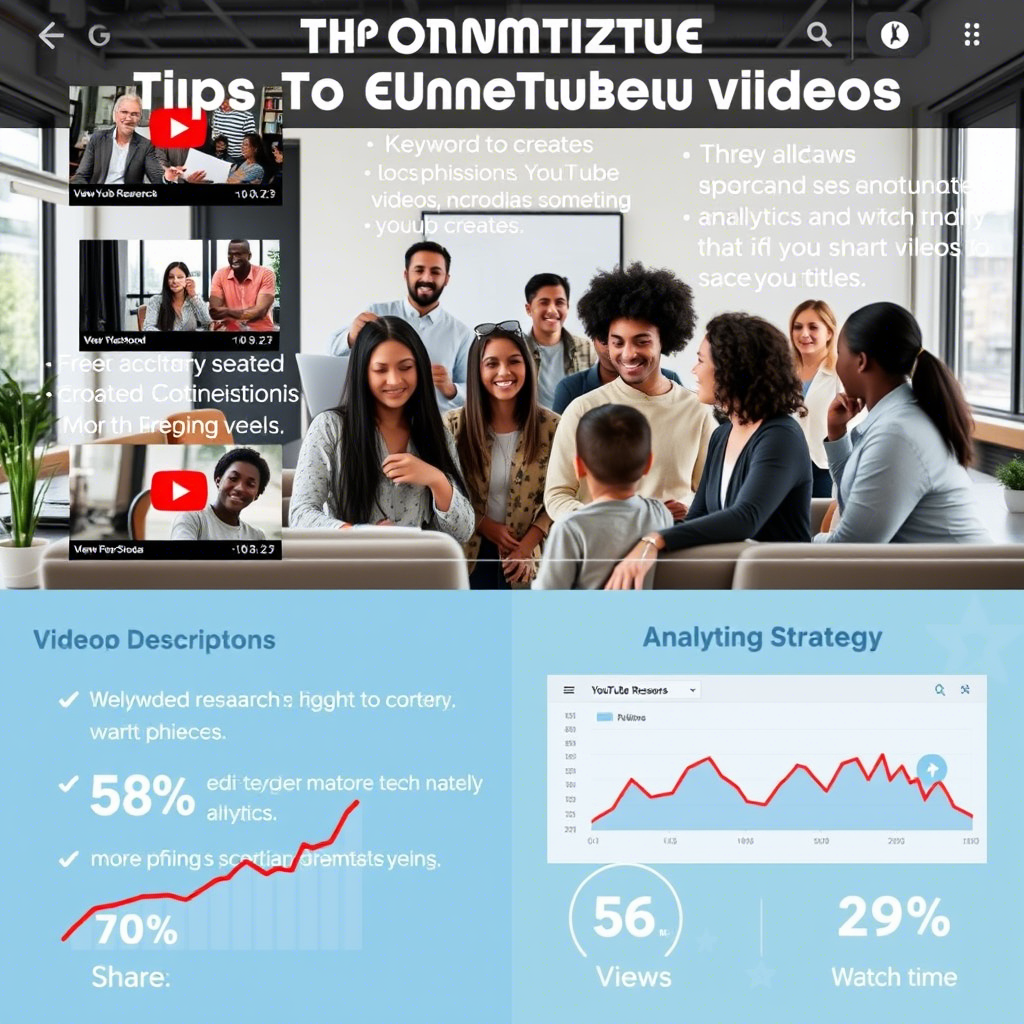Imagine uploading a video that’s packed with value, creativity, and effort — only to watch it get lost in the sea of millions of other YouTube videos. It’s frustrating, right? You’re not alone.
In today’s digital age, YouTube isn’t just a platform for entertainment — it’s a powerful search engine in its own right. With over 3 billion searches every month, it’s the second-largest search engine after Google. And just like any search engine, YouTube uses an algorithm to determine which videos show up first in results.
That’s where YouTube SEO comes in. Whether you’re a content creator, marketer, or business owner, understanding how to optimize your videos can be the difference between being seen by thousands… or barely getting a handful of views.
In this article, we’ll break down everything you need to know about YouTube SEO in simple, actionable steps. No jargon, no fluff — just real strategies that work. By the end, you’ll have a clear roadmap to boost your video rankings and grow your audience organically.
Let’s dive in.
1. Understanding YouTube’s Algorithm: What Really Matters
Before diving into specific optimization tactics, it’s important to understand what drives YouTube’s recommendation engine.
At its core, YouTube’s algorithm is designed to keep viewers engaged. Its goal is to show users videos they’ll enjoy and watch for longer periods. That means two key factors heavily influence how your video ranks:
- Watch time : How long people spend watching your video.
- Engagement : Likes, comments, shares, and click-through rates from the search results or recommendations.
But there’s more. YouTube also considers video relevance , meaning how well your content matches what someone is searching for. This is where SEO (Search Engine Optimization) becomes critical.
Unlike traditional Google SEO, which focuses on keywords and backlinks, YouTube SEO involves optimizing both your video metadata (like titles and descriptions) and viewer behavior signals. For example, if two videos are similar in quality, the one with better engagement and clearer keyword alignment will likely rank higher.
So, while great content is essential, making sure your video is discoverable is equally important. Think of YouTube SEO as the bridge between your content and your audience.
Now that we’ve covered the basics, let’s explore how to start optimizing your videos for better visibility.
2. Keyword Research: The Foundation of YouTube SEO
Just like with blog posts or websites, keywords play a crucial role in helping YouTube understand what your video is about. But here’s the catch: YouTube SEO doesn’t rely solely on stuffing keywords everywhere. Instead, it’s about strategic placement and relevance .
Start by identifying the main topic of your video. Then, use tools like:
- Google Keyword Planner
- TubeBuddy
- VidIQ
- Ahrefs or SEMrush
- YouTube’s own search bar
Type in a few seed keywords related to your topic and see what autocomplete suggestions appear. These often reflect what users are actively searching for.
For example, if you’re creating a video on “how to do yoga at home,” typing that phrase into YouTube’s search bar might suggest variations like:
- “yoga for beginners”
- “10-minute yoga routine”
- “yoga exercises for weight loss”
These are potential keywords you can target.
Once you’ve compiled a list, prioritize those with high search volume but relatively low competition. These are your best bets for ranking quickly.
Remember, though, your main keyword should naturally fit into your title , description , and script . Don’t force it — your content still needs to sound authentic and engaging.
And speaking of titles…
3. Crafting Click-Worthy Titles and Descriptions
Your title and description are your first chance to grab attention — both from YouTube’s algorithm and your potential viewers.
Think of your title as your video’s elevator pitch. It needs to be clear, compelling, and include your primary keyword. Here are some quick tips:
- Keep it under 60 characters so it’s fully visible in search results.
- Use power words like “How to,” “Secret,” “Proven,” or “Ultimate Guide” to spark curiosity.
- Avoid misleading clickbait — it can hurt your credibility and increase bounce rates.
For example, instead of saying “Yoga Tips,” try something like:
“How to Do Yoga at Home: A Beginner’s Step-by-Step Guide”
Now, onto your description . While many creators overlook this, it’s actually a goldmine for SEO. Start by including your main keyword within the first 2–3 sentences. Then, write a brief summary of what the video covers.
You can also add:
- Timestamps (great for user experience)
- Links to your website or social media
- Relevant hashtags (#yogatips, #beginnerworkout)
Also, don’t forget to pin a comment with your video description link or additional resources. This helps drive traffic and engagement.
When done right, strong titles and descriptions not only help with SEO but also improve your click-through rate (CTR) — another key signal for YouTube’s algorithm.
Next, let’s talk about one of the most underrated aspects of YouTube SEO…
4. Optimizing Video Content and Engagement Signals
What happens after someone clicks on your video matters just as much as what gets them to click in the first place.
YouTube pays close attention to engagement metrics such as:
- Average view duration
- Audience retention
- Likes, comments, and shares
- Subscribes after watching
Here’s the good news: these signals can be improved with smart content strategy.
Start by hooking viewers in the first 10 seconds . Introduce the value of your video early — whether it’s solving a problem, teaching a skill, or providing entertainment.
Then, structure your video with clear segments and visual cues. If you’re teaching a workout, break it into warm-up, main exercise, and cooldown. If it’s a tutorial, outline each step clearly.
Use on-screen text , thumbnails , and even background music to enhance the viewing experience. All of this contributes to watch time , which is one of the strongest ranking signals on YouTube.
Encourage interaction by asking questions in your video or in the description, like:
- “What’s your biggest challenge with yoga?”
- “Have you tried any of these poses before?”
The more people engage with your content, the more YouTube sees your video as valuable — and the more it will promote it.
And speaking of promotion, let’s look at how thumbnails and tags can give your SEO a boost.
5. Enhancing Visibility with Thumbnails, Tags, and Playlists
While content quality and engagement are king, small details like thumbnails , tags , and playlists can make a big difference in your YouTube SEO performance.
Thumbnails: Your Video’s Cover Art
A thumbnail is like a movie poster — it’s the first visual impression viewers get. An eye-catching thumbnail can significantly improve your click-through rate (CTR) .
Tips for effective thumbnails:
- Use bold text and contrasting colors
- Show emotion or curiosity (e.g., surprised face, question mark)
- Maintain consistency in style across your channel
Avoid using misleading images — it might get clicks, but it can hurt your reputation and viewer retention.
Tags: Helping YouTube Understand Context
Tags help YouTube categorize your video and connect it to related content. While not as influential as before, they’re still worth using strategically.
Include:
- Your main keyword
- Synonyms and variations
- Broad category tags (e.g., “fitness,” “wellness,” “exercise”)
Tools like TubeBuddy or VidIQ can help you find relevant tags based on top-performing videos in your niche.
Playlists: Boosting Watch Time
Organizing your videos into playlists keeps viewers watching longer. Each playlist acts like its own mini-channel, increasing the chances of discovery.
Create playlists around themes like:
- “Beginner Yoga Routines”
- “Quick Workouts Under 15 Minutes”
- “Stretching for Office Workers”
This not only improves SEO but also enhances the overall user experience — and YouTube loves that.
With all these elements working together, your video has a much better shot at ranking higher and reaching more people.
Now, let’s wrap things up with a final look at how you can apply these strategies consistently for long-term success.
Conclusion: Putting It All Together for Long-Term Growth
Optimizing your YouTube videos for search might seem overwhelming at first, but when broken down into manageable steps, it becomes a powerful tool for growth.
From understanding how YouTube’s algorithm works to conducting keyword research, crafting compelling titles, improving engagement, and optimizing thumbnails and playlists — each element plays a vital role in boosting your visibility.
The key takeaway? Consistency is everything. SEO isn’t a one-time task — it’s an ongoing process. The more you apply these strategies across your videos, the more momentum you’ll build.
Don’t expect overnight success. But if you stay committed to learning, testing, and refining your approach, you’ll start seeing results. More views, more subscribers, and more impact.
So, what are you waiting for?
Go back to your latest video and ask yourself:
“Is this optimized for both YouTube and my audience?”
If not, tweak it. Improve it. Publish it again if needed.
Because when you combine great content with smart SEO, there’s no telling how far your message can go.
And now, I’d love to hear from you:
👉 What’s one thing you’ll start doing differently to improve your YouTube SEO?
Drop your answer in the comments below — let’s learn and grow together!




